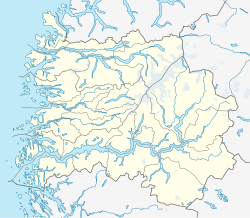Hove Church
| Hove Church | |
|---|---|
| Hove kyrkje | |
 Hove Church overlooking Vikøyri on the Arnafjord | |
| 61°04′18″N 6°35′02″E / 61.0716°N 6.5840°E | |
| Location | Vik Municipality, Sogn og Fjordane |
| Country | Norway |
| Denomination | Church of Norway |
| Churchmanship | Evangelical Lutheran |
| History | |
| Status | Parish church |
| Architecture | |
| Functional status | Active |
| Completed | c. 1170 |
| Specifications | |
| Capacity | 35 |
| Materials | Stone |
| Administration | |
| Diocese | Diocese of Bjørgvin |
| Deanery | Indre Sogn prosti |
| Parish | Vik |
Hove Church (Template:Lang-no) is a historic parish church in Vik Municipality in Sogn og Fjordane county, Norway. It is located in the village of Vikøyri on the Arnafjord, an arm of Sognefjord. The old parish of Hove (together with Hopperstad) was abolished in 1875, and replaced by the new, united, Vik parish. The church and parish of Vik is a part of Indre Sogn deanery in the Diocese of Bjørgvin. The stone church was built around the year 1170. Historians believe it was built for a wealthy man who belonged to the very upper echelon within the Norwegian aristocracy. They say he had built this as a private chapel with seating for only about 35 people.[1][2]
History
Architect Peter Andreas Blix (1831– 1901) bought the church in 1880 and restored the church between 1883-1888. Blix's goal was to finish the stone church to its original conditions. Soapstone for repairing the walls were brought from the old soapstone quarry in the municipality. Just as when he renovated the nearby Hopperstad Stave Church, Blix removed all the fixtures that were not from the Middle Ages. On the exterior Blix built up a large stone tower on the old base of the tower (it had been a wooden tower from 1600 until the 1880s). It is uncertain whether the church had a wood or a stone tower originally. Blix died in 1901 and he is buried under the floor of the church.[2] He owned the church until his death, and bequeathed it to his brother who then gave it to the state.[3]
The church is still owned by the state, and it is administered by the Society for the Preservation of Ancient Norwegian Monuments. It is no longer regularly used by the parish, but it can be used for special occasions such as weddings or funerals. [4]
Gallery
See also
References
- ^ "Hove steinkyrkje". Kirkesøk: Kirkebyggdatabasen. Retrieved 2014-01-24.
- ^ a b "Hove steinkyrkje" (in Norwegian). Sogn og Fjordane Fylkesarkiv. Retrieved 2014-01-24.
- ^ "Peter Andreas Blix". Store norske leksikon. Retrieved October 1, 2016.
- ^ Nina Aldin Thune. "Hove kirke". Store norske leksikon. Retrieved October 1, 2016.














